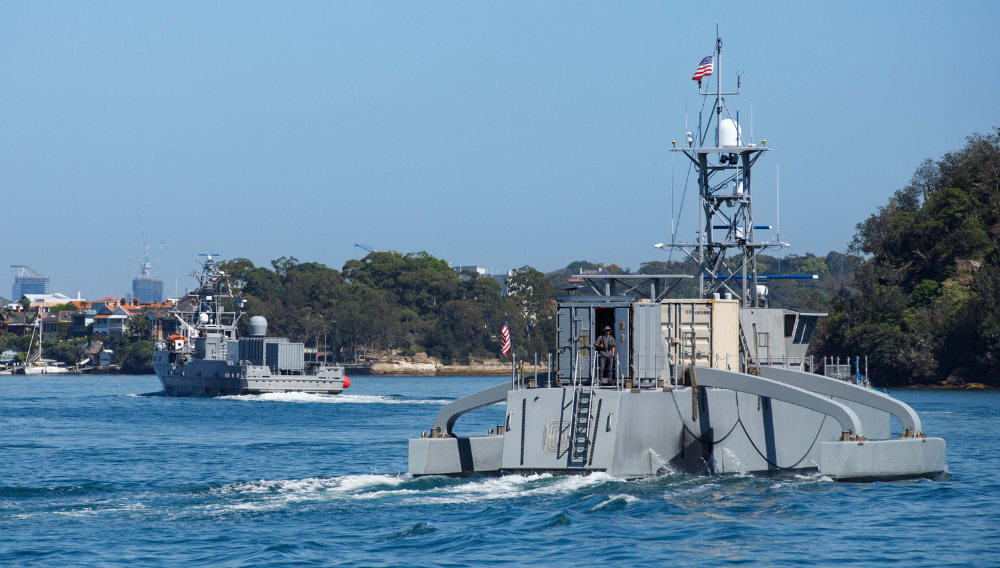2 min read
RTI at XPONENTIAL 2024: Taking Control of Unmanned Systems
 John Breitenbach
:
April 18, 2024
John Breitenbach
:
April 18, 2024

[Photo source: DVIDS (Defense Visual Information Distribution Service), October, 24, 2023; Unmanned Surface Vessel Division One Arrives in Sydney Harbor; The appearance of U.S. Department of Defense (DoD) visual information does not imply or constitute DoD endorsement.]
When it comes to building autonomous systems, connectivity is king. A great illustration of this truism is found in the increasing adoption of the Modular Open Systems Approach (MOSA) across the Joint Forces – not only for unmanned system development, but also to improve data sharing for better cooperation across the different branches of the military.
Need proof of just how fast MOSA is taking over the development landscape? The U.S. House of Representative recently passed a defense funding bill with hundreds of millions of budget earmarked for autonomous systems. This bill also includes specific programs that mandate the use of both UMAA and the Data Distribution Service (DDS™) standard in developing next-generation systems, vehicles and devices.
The Department of Defense is serious about getting autonomous systems to our troops quickly. Deputy Secretary of Defense Kathleen Hicks recently announced the Replicator program. Replicator's goal is to deliver between 10 to 20 thousand unmanned systems to the field in under two years. And the areas they're looking at are primarily self-piloting ships and unmanned aircraft.
As a result of all this activity, it’s fair to say that smarter connectivity in real time has become the secret weapon for autonomous system developers. Smart connectivity software eases integration with important legacy systems, while bridging them to the latest autonomy and AI technology. Interoperability across different software stacks, containers, operating systems, programming languages and networks means that developers can mix and match from the best available tools for each function of the system.
As autonomous and unmanned systems are rapidly fielded, they will serve as distributed sensor and effector platforms. Data from these systems must be moved to C2 systems so that military leadership can decide their course of action. Some data must also be shared with our joint and allied mission partners. Open standards for data exchange are critical to joint operations.
When developing unmanned systems, how do you follow MOSA guidelines and work seamlessly with standards such as UMAA for maritime vehicles, FACE®, SOSA™,NGVA and more? What ties it all together is the Object Management Group® (OMG®) Data Distribution Service (DDS™) standard.
As the #1 standard for software interoperability, DDS naturally encourages a MOSA approach. With DDS, shared data is the main asset in the system even as applications come and go – a concept called data centricity. Software applications and services become isolated from their hardware, their operating systems, their network, and from each other. Applications are decoupled in time, location, and flow. The result is a loosely coupled architecture that encourages parallel development and that is easy to upgrade over time – which are the stated goals of MOSA.
Here at RTI, we’re well versed in helping customers with these types of challenges. That’s why RTI will be exhibiting at this year’s AUVSI™ XPONENTIAL™ event, a yearly gathering of global leaders and technical experts in the unmannned systems and robotics industry. XPONENTIAL 2024 will take place in San Diego, California from April 22 - 25, where RTI will showcase its latest product release and demonstrate why Connext is already widely used across different branches of the U.S. Armed Forces and beyond.
So join RTI at AUVSI XPONENTIAL in booth #2722 to learn how we can help. And for more information on how RTI supports MOSA objectives, please click here.
About the author:
 John Breitenbach, Director Aerospace & Defense Markets, RTI
John Breitenbach, Director Aerospace & Defense Markets, RTI
John Breitenbach is Director of Aerospace & Defense Markets for Real-Time Innovations. He has over 30 years of experience designing software for intelligent machines. He’s worked on industrial, medical, consumer and military products - everything from artificial hearts to autonomous vehicles to elevators.
Posts by Tag
- Developers/Engineer (180)
- Technology (79)
- Connext Suite (77)
- News & Events (75)
- 2020 (54)
- Aerospace & Defense (53)
- Standards & Consortia (51)
- Automotive (38)
- 2023 (34)
- 2022 (29)
- IIoT (27)
- 2025 (25)
- Leadership (24)
- Healthcare (23)
- 2024 (22)
- Connectivity Technology (21)
- Cybersecurity (20)
- 2021 (18)
- Culture & Careers (15)
- Military Avionics (15)
- FACE (13)
- Connext Pro (10)
- JADC2 (10)
- ROS 2 (10)
- Connext Tools (7)
- Connext Micro (6)
- Databus (6)
- Transportation (5)
- Case + Code (4)
- Connext (4)
- Connext Cert (4)
- Energy Systems (4)
- FACE Technical Standard (4)
- AI (3)
- Oil & Gas (3)
- Research (3)
- Robotics (3)
- Connext Conference (2)
- Edge Computing (2)
- Golden Dome (2)
- MDO (2)
- MS&T (2)
- RTI Labs (2)
- TSN (2)
- ABMS (1)
- C4ISR (1)
- DOD (1)
- ISO 26262 (1)
- L3Harris (1)
- LabView (1)
- MOSA (1)
- MathWorks (1)
- National Instruments (1)
- Simulation (1)
- Tech Talks (1)
- UAM (1)
- Videos (1)
- eVTOL (1)
 Success-Plan Services
Success-Plan Services